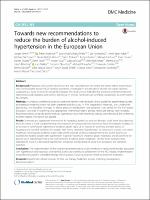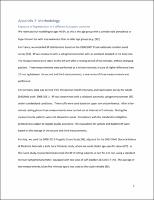Towards new recommendations to reduce the burden of alcohol-induced hypertension in the European Union
| dc.contributor | Departament de Salut |
| dc.contributor.author | Rehm, Jürgen |
| dc.contributor.author | Anderson, Peter |
| dc.contributor.author | Arbesu, Jose Angel |
| dc.contributor.author | Armstrong, Iain |
| dc.contributor.author | Aubin, Henri-Jean |
| dc.contributor.author | Bachmann, Michael |
| dc.contributor.author | Colom Farran, Joan |
| dc.contributor.author | Segura-García, Lidia |
| dc.date.accessioned | 2022-02-08T14:16:02Z |
| dc.date.available | 2022-02-08T14:16:02Z |
| dc.date.issued | 2017-09-28 |
| dc.identifier.citation | Rehm J, Anderson P, Arbesu Prieto JA, Armstrong I, Aubin HJ, Bachmann M, et al. Towards new recommendations to reduce the burden of alcohol-induced hypertension in the European Union. BMC Med. 2017 Sep 28;15(1):173. |
| dc.identifier.issn | 1741-7015 |
| dc.identifier.uri | https://hdl.handle.net/11351/6990 |
| dc.description | Consum d'alcohol; Pressió sanguínea; Atenció primària; Recomanacions |
| dc.description.sponsorship | The workshop entitled “Screening and intervention for harmful alcohol use as a tool to improve the management of hypertension in primary care”, held on November 12, 2015, in Barcelona, Spain, was financially supported by Lundbeck (in providing travel allowances for some participants). An agenda of the workshop can be found in Additional file 1: Appendix 1. |
| dc.language.iso | eng |
| dc.publisher | BioMed Central |
| dc.relation.ispartofseries | BMC medicine;15(1) |
| dc.rights | Attribution 4.0 International |
| dc.rights.uri | http://creativecommons.org/licenses/by/4.0/ |
| dc.source | Scientia |
| dc.subject | Hipertensió - Estudi de casos |
| dc.subject | Alcoholisme - Estudi de casos |
| dc.subject | Atenció primària - Unió Europea |
| dc.subject.mesh | Alcoholism |
| dc.subject.mesh | Hypertension |
| dc.subject.mesh | /prevention & control |
| dc.subject.mesh | Primary Health Care |
| dc.subject.mesh | European Union |
| dc.title | Towards new recommendations to reduce the burden of alcohol-induced hypertension in the European Union |
| dc.type | info:eu-repo/semantics/article |
| dc.identifier.doi | 10.1186/s12916-017-0934-1 |
| dc.subject.decs | alcoholismo |
| dc.subject.decs | hipertensión |
| dc.subject.decs | /prevención & control |
| dc.subject.decs | atención primaria de la salud |
| dc.subject.decs | Unión Europea |
| dc.relation.publishversion | https://doi.org/10.1186/s12916-017-0934-1 |
| dc.type.version | info:eu-repo/semantics/publishedVersion |
| dc.audience | Professionals |
| dc.contributor.authoraffiliation | [Rehm J] Institute for Mental Health Policy Research, Centre for Addiction and Mental Health, Toronto, Canada. Campbell Family Mental Health Research Institute, Centre for Addiction and Mental Health, Toronto, Canada. Addiction Policy, Dalla Lana School of Public Health, University of Toronto, Toronto, Canada. Institute of Medical Science, University of Toronto, Faculty of Medicine, Medical Sciences Building, Toronto, Canada. Department of Psychiatry, University of Toronto, Toronto, Canada. Institute of Clinical Psychology and Psychotherapy, Technische Universität Dresden, Dresden, Germany. [Anderson P] Substance Use, Policy and Practice, Institute of Health and Society, Newcastle University, Newcastle upon Tyne, UK. Alcohol and Health, Faculty of Health, Medicine and Life Sciences, Maastricht University, Maastricht, Netherlands. [Arbesu Prieto JA] Primary Care Center La Eria, Oviedo, Spain. Primary Care Spanish Society SEMERGEN, Madrid, Spain. [Armstrong I] Health and Wellbeing Directorate, Public Health England, London, UK. [Aubin HJ] CESP, University Paris-Sud, UVSQ, INSERM, Université Paris-Saclay, APHP, Hôpitaux Universitaires Paris-Sud, Villejuif, France. [Bachmann M] Copentown Healthcare Consultants, Cape Town, South Africa. [Colom J, Segura-Garcia L] Programa d’Abús de Substàncies, Agència Pública de Salut de Catalunya, Departament de Salut, Generalitat de Catalunya, Barcelona, Spain |
| dc.identifier.pmid | 28954635 |
| dc.rights.accessrights | info:eu-repo/semantics/openAccess |

 Àrea privada
Àrea privada Contacte
Contacte









